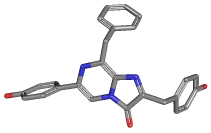|
COELENTERAZINE |
| Synonyms. Coelenterazine; Oplophorus luciferin; 2-(p-Hydroxybenzyl)-6-(p-hydroxyphenyl)-8-benzyl-imidazo[1,2-a]pyrazin-3-(7H)-one; 3,2-Dihydro-2-(p-hydroxybenzyl)-6-(p-hydroxyphenyl)-8-benzylimidazolo[1,2-a]pyrazin-3-one; CLZN; 2-(4-Hydroxybenzyl)-6-(4-hydroxyphenyl)-8-benzyl-3,7-dihydroimidazo(1,2-a)pyrazin-3-one; |
|
|
| PRODUCT IDENTIFICATION | |
|
CAS RN |
55779-48-1 |
|
EINECS RN |
|
|
FORMULA |
C26H21N3O3 |
|
MOLE WEIGHT |
423.46 |
|
H.S CODE |
2934.90.9000 |
|
SMILES |
n12c(nc(c1=O)Cc1ccc(cc1)O)c([nH]c(c2)c1ccc(O)cc1)Cc1ccccc1 |
|
CLASSIFICATION |
Luminescent Agent |
|
EXTRA NOTES |
Luminophore of the aequorin complex which is oxidized by oxygen to illuminate at 465 nm when Ca2+ binds to the complex; used to measure Ca2+ concentration in cells with high sensitivity and large dynamic range (sigmaaldrich) |
|
|
| PHYSICAL AND CHEMICAL PROPERTIES | |
|
PHYSICAL STATE. |
yellowish to brown crystalline powder |
|
MELTING POINT |
175 ~ 179 C |
|
BOILING POINT |
|
|
DENSITY |
|
|
SOLUBILITY IN WATER |
|
| SOLVENT SOLUBILITY |
|
|
VAPOR DENSITY |
|
|
log P(octanol-water) |
|
|
VAPOR PRESSURE |
|
|
AUTOIGNITION TEMP |
|
| pH |
|
|
REFRACTIVE INDEX |
|
|
FLASH POINT |
|
|
|
| STABILITY AND REACTIVITY | |
| STABILITY | Stable under normal conditions. Light sensitive. |
|
INCOMPATIBLE MATERIALS |
Strong oxidizing agents. |
| POLYMERIZATION |
Has not been reported |
|
NFPA RATINGS |
Health: 0, Flammability: 0, Reactivity: 0 |
|
|
| EXTERNAL LINKS & GENERAL DESCRIPTION |
|
Wikipedia Linking - Coelenterazine Google Scholar Search - Coelenterazine Drug Information Portal (U.S. National Library of Medicine) - Coelenterazine PubChem Compound Summary - Coelenterazine KEGG (Kyoto Encyclopedia of Genes and Genomes) - Coelenterazine Chemical Entities of Biological Interest (ChEBI) - Coelenterazine http://www.ncbi.nlm.nih.gov/ - Coelenterazine http://www.lifesci.ucsb.edu/ |
|
|
| SALES SPECIFICATION | |
|
APPEARANCE |
yellowish to brown crystalline powder |
|
PURITY |
95.0% min (TLC) |
|
MELTING POINT |
175 ~ 179 C |
|
|
| TRANSPORT & REGULATORY INFORMATION | |
|
UN NO. |
|
| HAZARD CLASS |
|
| PACKING GROUP | |
|
|
| SAFETY INFORMATION | |
|
HAZARD OVERVIEW |
OSHA Hazards:No known hazards. May cause long lasting harmful effects to aquatic life. Eyes: Causes eye irritation. Skin: May be harmful if absorbed through skin. Causes skin irritation. Inhalation: May be harmful if inhaled. Causes respiratory tract irritation. Ingestion: May be harmful if swallowed. |
|
GHS |
|
|
SIGNAL WORD |
Warning |
|
PICTOGRAMS |
|
|
HAZARD STATEMENTS |
H413 |
|
P STATEMENTS |
|
| EC DIRECTIVES |
|
| HAZARD CODES |
|
|
RISK PHRASES |
36/37/38 |
|
SAFETY PHRASES |
24/25-26-28-36/37/39 |
|
|
| PACKING |
|
Preserve in light-resistant and well-closed containers |
|
|
| PRICE INFORMATION |
|
|

